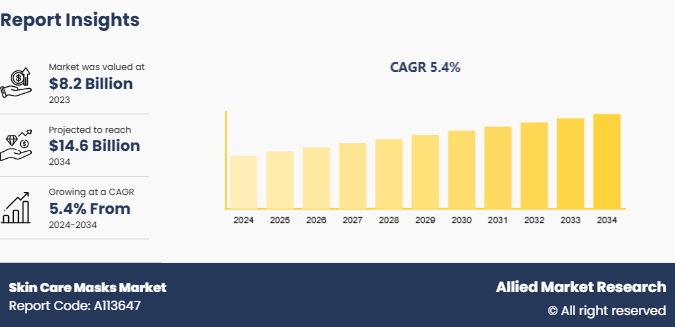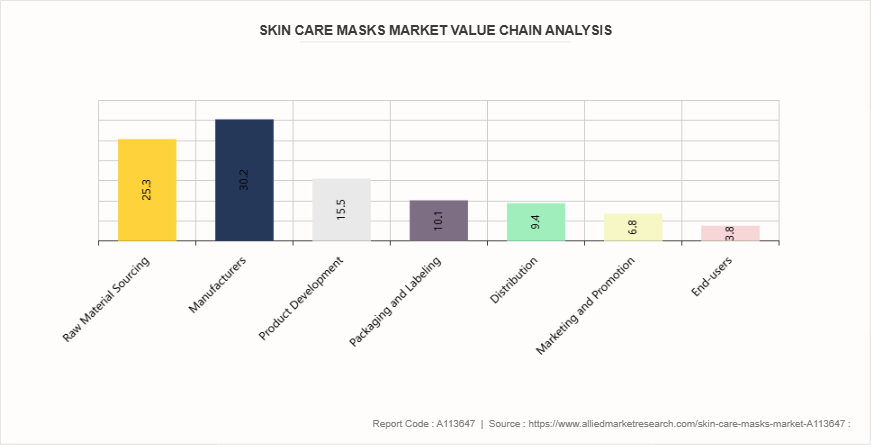Skin Care Masks Market Research, 2034
The global skin care masks market size was valued at $8.2 billion in 2023, and is projected to reach $14.6 billion by 2034, growing at a CAGR of 5.4% from 2024 to 2034. A skin care mask is a sheet of tissue that is applied on the face to improve skin health and appearance. These masks come in various forms, including sheet masks, cream masks, and clay masks, each designed to target specific skin concerns such as dryness, acne, or signs of aging.

The mask is made from materials such as cotton, gel, or clay, which are infused with active ingredients such as hyaluronic acid, vitamins, and botanical extracts. Users apply the mask after cleansing their face and leave it on for a specified duration to allow the ingredients to penetrate effectively. After removal, the skin feels refreshed, hydrated, and rejuvenated. Regular use of skin care masks helps get a clearer and healthier complexion, which has made them a popular addition to many skincare routines.
Key Takeaways
The skin care masks market study covers 20 countries. The research includes a segment analysis of each country in terms of value ($Billion) for the projected period 2024-2034.
More than 1, 500 product literatures, industry releases, annual reports, and other such documents of major skin care masks industry participants along with authentic industry journals, trade associations' releases, and government websites have been reviewed for generating high-value industry insights.
The study integrated high-quality data, professional opinions and analysis, and critical independent perspectives. The research approach is intended to provide a balanced view of global markets and to assist stakeholders in making educated decisions in order to achieve their most ambitious growth objectives.
Key Market Dynamics
The rise in demand for natural and organic skincare products has led to an increase in size of the skin care masks market. Consumers seek products that include nature-based ingredients such as aloe vera, green tea, and charcoal, which are perceived as safer alternatives to chemical-based solutions. Manufacturers have responded by producing masks that cater to the increase in demand for natural and organic skincare products.
For instance, Tata Harper launched the Superkind Radiance Mask in July 2024 with infusion of natural extracts in it. Similarly, Kora Organics introduced the Turmeric Brightening & Exfoliating Mask in March 2024, featuring certified organic components. These launches highlight the continued market growth for skin care masks formulated with nature-based ingredients.
In addition, the demand for organic skincare highlights a shift toward products that promote well-being without synthetic additives. Thus, companies serving the growing demand are expected to experience higher customer interest and retention, while driving skin care masks market expansion in the coming years.
However, high competition from other skincare alternatives restrains the market demand for skin care masks by offering consumers a wide range of options. Serums, facial oils, and exfoliating scrubs, which provide benefits such as hydration, brightening, and anti-aging effects, usually draw attention from consumers who want targeted or multi-functional products. The presence of these alternatives impacts the demand for traditional and new types of skin care masks. Popular categories, including peels, and leave-on treatments, further adds to the competitive environment, attracting customers who seek convenience and shorter treatment times.
Moreover, hybrid products that combine skincare and makeup lead to an increase in competition and divert consumer interest from masks. Such skin care alternatives make it challenging for both established and emerging brands to gain market share and build consumer loyalty. So, the wide range of skincare options affects the frequency of mask purchases, ultimately hindering the skin care masks market growth.
Furthermore, the adoption of technology-driven skin analysis and mask recommendations creates significant opportunities in the skin care masks market share by increasing personalization and consumer engagement. Advanced tools, including AI-based skin analyzers and app-integrated consultations, allow consumers to receive tailored advice on the most suitable masks for their skin type and concerns.
Brands such as FOREO introduced the UFO 3 smart mask device in June 2024, which uses sensors to assess skin condition and recommend treatments. Neutrogena launched the Skin360 app in April 2024, which scans the skin and suggests customized skincare products, including skin care masks. This technology-driven approach aligns with the growing trend of personalized beauty routines, and helps attract consumers seeking effective, data-backed solutions.
The integration of skin analysis with product recommendations supports informed decision-making, which results in higher consumer trust and boost in sales of skin care mask products. Thus, companies that utilize such innovations in skin care masks segment are anticipated to expand their reach and improve customer loyalty within the market during the skin care masks market forecast.
Value Chain of the Global Skin Care Masks Market

The value chain of the skin care masks market involves several key stages, starting with raw material sourcing, where natural, organic, or synthetic ingredients are sourced from suppliers. These ingredients, including plant extracts, clay, and essential oils, are then processed and formulated by manufacturers.
The next stage is product development, where brands create mask formulations that address specific skin concerns. Once the product is developed, packaging and labeling takes place, with increasing emphasis on eco-friendly and attractive packaging. Distribution follows with products reaching various sales channels such as online retail, supermarkets, and beauty stores. Marketing and promotion play a crucial role, with advertisements, influencers, and social media campaigns driving consumer interest. Finally, the consumer purchases and uses the product, completing the value chain.
Market Segmentation
The global skin care masks market is segmented based on product type, ingredients, packaging, distribution channel, and region. Based on product type, the market is classified into sheet masks, clay masks, peel-off masks, thermal masks, and others. As per ingredients, it is categorized into natural/organic, and synthetic.
Based on packaging, the market is divided into tube, sachet, and bottle. Depending on distribution channel, the market is fragmented into hypermarkets/supermarkets, specialty stores, departmental stores, online sales channel, and others. Region wise, the market is analyzed across North America, Europe, Asia-Pacific, and LAMEA.
Regional/Country Market Outlook
The demand for skin care masks has experienced a rapid boost in North America owing to increase in consumer awareness regarding skincare and wellness. Established brands such as L'Oreal, Estee Lauder, and Procter & Gamble dominate the market, offering a wide range of skin care mask products tailored to various skin types. Recent innovations such as light therapy acne mask launched by Neutrogena in July 2024, and the silk peony melting eye mask, introduced in March 2024 by Tatcha, reflect consumer preference for advanced, multifunctional skincare solutions.
Brands are expanding their presence in the region through digital marketing, influencer partnerships, and pop-up stores to target younger, tech-savvy consumers. North American consumers increasingly prefer personalized skincare options, with a focus on clean, cruelty-free, and eco-conscious products, thus influencing brand strategies to align with these values.
The Asia-Pacific skin care masks market is growing rapidly owing to the rise in consumer interest in natural and organic skincare products. Brands such as Innisfree, The Face Shop, and SK-II offer masks focused on clean and effective ingredients. High demand is observed in countries, such as South Korea, Japan, and China, where skincare routines are widely practiced.
Government initiatives, like Korea Cosmetic Act in South Korea, ensure strict product safety and ingredient transparency, which helps new brands enter the market. In China, the National Medical Products Administration (NMPA) implements regulations that prioritize product safety, creating a favorable condition for new players to launch their brands. With the increase in demand for personalized and eco-conscious beauty products, there are substantial growth opportunities for emerging brands of skin care masks in the Asia-Pacific region.
Industry Trends:
The skin care masks market share has seen increased interest in customizable skincare solutions, with brands focusing on products that target specific skin concerns such as acne, sensitivity, and pigmentation. Consumers now seek masks that offer both convenience and effectiveness, such as overnight and wash-off options. In addition, sustainability has become a priority, with many brands opting for biodegradable or recyclable packaging.
In recent months, stricter regulations in regions such as the European Union have focused on improving ingredient transparency and allergen labeling, thus ensuring higher consumer safety. The growing popularity of self-care routines, especially among younger consumers, has driven greater incorporation of masks into daily skincare practices. Moreover, social media influencers and beauty bloggers have played a key role in promoting new products and techniques, further boosting demand and shaping consumer choices.
Competitive Landscape
The major players operating in the skin care masks market include L’Oreal Group, Unilever, Estee Lauder Companies Inc., Procter & Gamble, Johnson & Johnson, Shiseido Company, Limited, Amorepacific Corporation, Kose Corporation, Natura &Co, and Beiersdorf AG.
Recent Key Strategies and Developments
In April 2023, L’Oreal SA acquired Aesop, a luxury cosmetics brand in Australia for USD 2.5 billion, to strengthen the presence of Aesop globally. This acquisition is anticipated to expand the clay-based face masks infused with aloe vera and plant extracts globally.
In January 2022, Oscar Mayer introduced bologna-inspired hydrogel sheet face masks on Amazon in the U.S. to increase its online presence in the region.
In August 2021, Kanebo, a subsidiary of Kao Corporation, launched the smile performer mask to expand its product portfolio with items that have a reduced environmental impact. The mask is made from cotton by-products with biodegradable properties.
Key Benefits For Stakeholders
- This report provides a quantitative analysis of the market segments, current trends, estimations, and dynamics of the skin care masks market analysis from 2024 to 2034 to identify the prevailing skin care masks market opportunities.
- The market research is offered along with information related to key drivers, restraints, and opportunities.
- Porter's five forces analysis highlights the potency of buyers and suppliers to enable stakeholders make profit-oriented business decisions and strengthen their supplier-buyer network.
- In-depth analysis of the skin care masks market segmentation assists to determine the prevailing market opportunities.
- Major countries in each region are mapped according to their revenue contribution to the global market.
- Market player positioning facilitates benchmarking and provides a clear understanding of the present position of the market players.
- The report includes the analysis of the regional as well as global skin care masks market trends, key players, market segments, application areas, and market growth strategies.
Skin Care Masks Market Report Highlights
| Aspects | Details |
| Market Size By 2034 | USD 14.6 Billion |
| Growth Rate | CAGR of 5.4% |
| Forecast period | 2024 - 2034 |
| Report Pages | 287 |
| By Product Type |
|
| By Ingredients |
|
| By Packaging |
|
| By Distribution Channel |
|
| By Region |
|
| Key Market Players | Shiseido Company, Limited, Amorepacific Corporation, Beiersdorf AG, Kose Corporation., Natura &Co, Johnson & Johnson, L’Oreal Group, Procter & Gamble, The Estee Lauder Companies Inc., Hindustan Unilever Limited |
The global skin care masks market was valued at $8.2 billion in 2023.
The leading application of the skin care mask market is addressing specific skin concerns like hydration, anti-aging, and acne treatment.
Upcoming trends in the global skin care mask market include rise in demand for natural ingredients, eco-friendly packaging, personalized formulations, skincare masks for men, and online retail growth.
Based on region, Asia-Pacific held the highest market share in terms of revenue in 2023.
The major players operating in the skin care masks market include L’Oreal Group, Unilever, Estee Lauder Companies Inc., Procter & Gamble, Johnson & Johnson, Shiseido Company, Limited, Amorepacific Corporation, Kose Corporation, Natura &Co, and Beiersdorf AG.
Loading Table Of Content...



